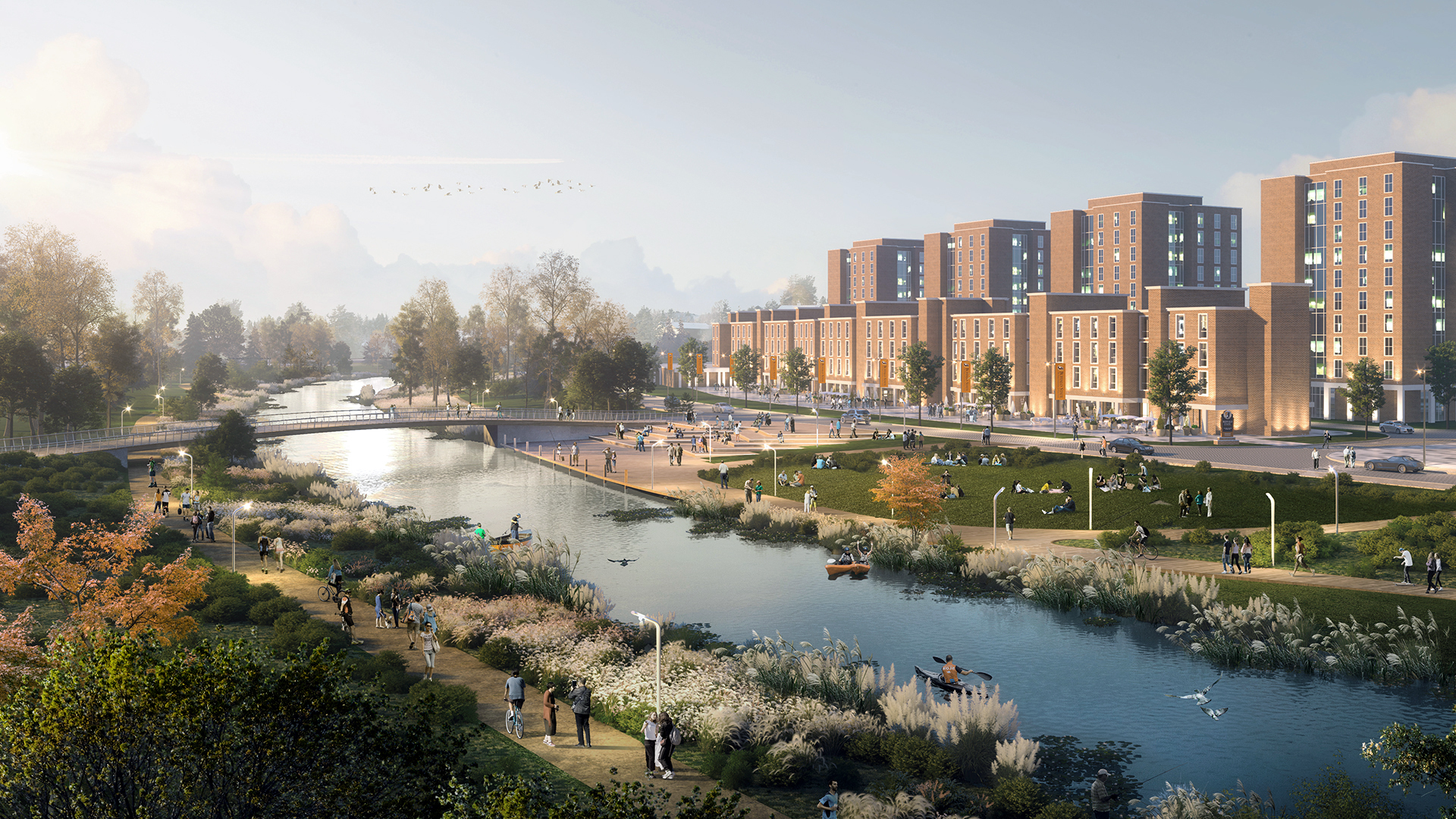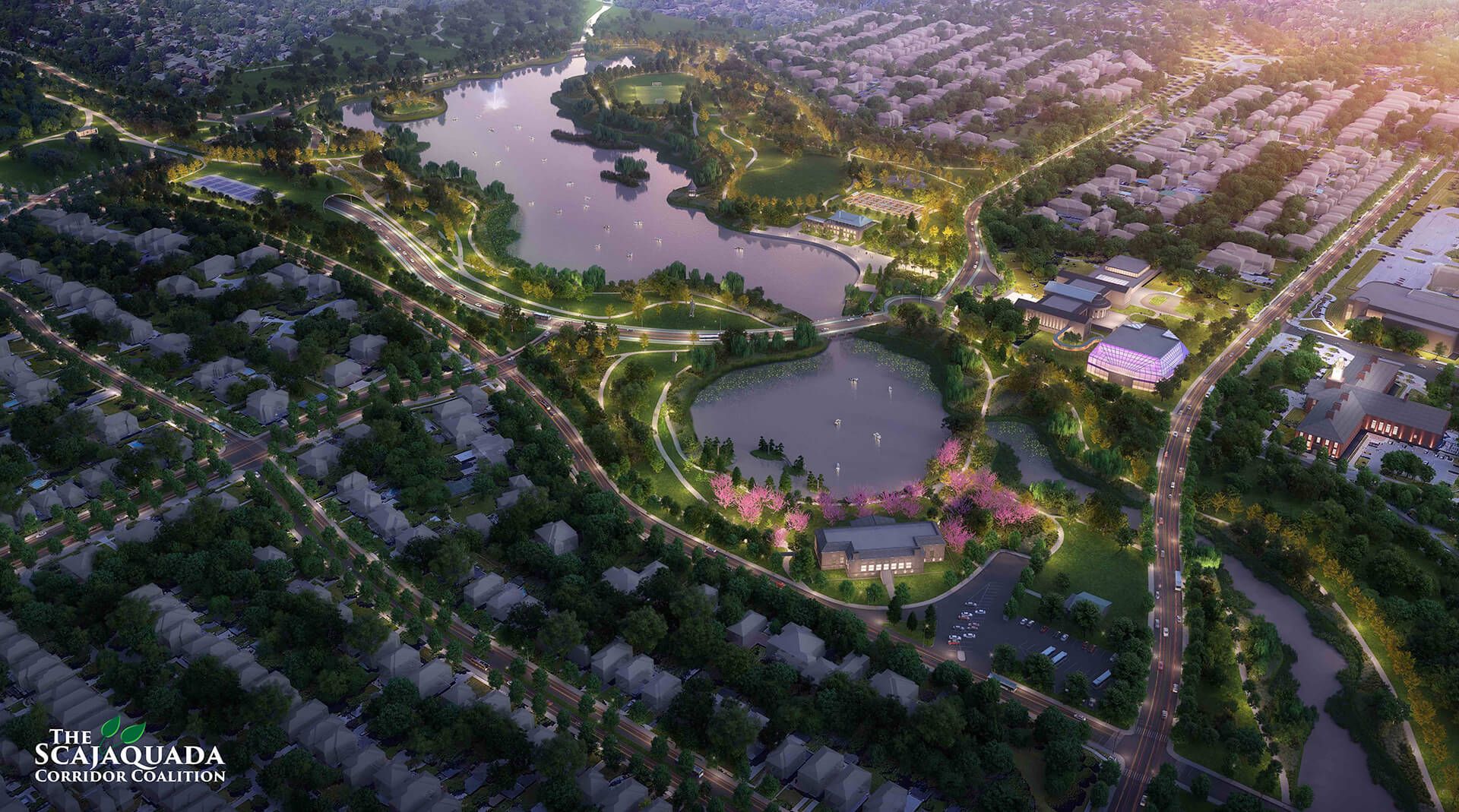First-generation Buffalonian, Luke Medina, knows first-hand what it was like to be separated from friends and communities:
“After the Kensington Expressway was built, the landscape of the neighborhood changed. To me, the expressway is a clear symbol of racism in Buffalo. Constructed during the civil rights movement through a historically Black community, the expressway destroyed Humboldt Park, a gateway in the Olmsted Park System, and treated my community and the other communities in East Buffalo as a pass-through.”
Buffalo now has a “seize the day” opportunity in front of us. Public outreach is now becoming a reality for redesign of the Scajaquada Expressway. Now is the time for the public to act, not dictated by our past mistakes, but by embracing concepts like micromobility options like e-bikes and e-scooters. It gives us the opportunity to expand trails and greenways.
“Because of the pandemic, we’ve learned that access to greenspaces and trails is not a privilege but a necessity, and one that’s not shared among all of our community members. Not only are they essential for maintaining physical and mental health, but also provide access to jobs and essential services.”
It is crucial we act now and begin to embrace ways for transportation choices with open access to all. Support the removal of the Scajaquada Expressway Follow us on social media (Twitter and Facebook) to stay involved.
Let's Dare to Dream
I’m a first-generation Buffalonian. I grew up on Rounds Avenue on Buffalo’s northeast side, near University at Buffalo’s south campus. My parents were the first generation in their families to grow up in the contiguous United States. My father was raised in East Harlem, and my mother grew up in Brooklyn, primarily in the Flatbush area.
After meeting at Syracuse University, my father accepted a teaching position in Buffalo while my mother completed law school at the University of Buffalo. My parents bought our home on Rounds Avenue for its highway access, but my mom took the bus a lot unless her work in prison reform took her outside of the city. On those days, she would take the car, and my dad would bike or take the bus to work. Both of my parents worked a lot to provide an opportunity for my brother and me. When I was young, they taught me about the importance of self-sufficiency. My dad, a martial artist, trained me in the value of hard work and humility. Growing up, I heard stories about how our neighborhood used to be in the 1950s–vibrant and full of life. When famous musicians were in town, they’d play at the theaters and music venues on Bailey Avenue.
After the Kensington Expressway was built, the landscape of the neighborhood changed. To me, the expressway is a clear symbol of racism in Buffalo. Constructed during the civil rights movement through a historically Black community, the expressway destroyed Humboldt Park, a gateway in the Olmsted Park System, and treated my community and the other communities in East Buffalo as a pass-through.
As a teenager, I felt sequestered in my neighborhood. Everything and everyone was far away. Because I went to school outside of my neighborhood, most of my friends lived on Buffalo’s lower west side. The easiest way to get there was by bike so I learned to plan for the 14-mile round-trip ride to see my friends. Biking became a meditative practice for me. Not only could I burn some calories, but I also had the freedom of exploration. I wonder what would have happened had the Kensington Expressway never been constructed. Maybe East Buffalo would be a better destination? Perhaps the entire City of Buffalo would have done better in the past 60 years? Would the air quality be better? Would Buffalo still be one of the most segregated cities in the country? Maybe I wouldn’t have to travel so far to support myself or see my friends? Perhaps I wouldn’t need a car? One can only wonder.
Luke is GObike’s newest team member, an Americorps intern working on community engagement in Buffalo. His story, while unique, is all of our stories– one of optimism, opportunity, and dreaming of possibilities, a story of wanting a better future and righting past wrongs.
When we built the Scajaquada and Kensington expressways in the 1960s, many believed the construction would bring more opportunity to the City of Buffalo. By connecting our city to the new New York State thruway and connecting to the interstate highways, we thought we were building, “a city of tomorrow.” We’d save time and money, create pathways to new business, and connect people to country homes with short commutes to work. We decided this was our path to a better future. “Clearly, this is a solution to our traffic problems,” touted the New York State Thruway Administration. We were wrong.
Instead of opportunity, we got a mere few minutes off our commute. The expressways split communities in half, destroyed Buffalo’s world-renowned Olmsted park system, and brought noise, air and land pollution as well as the heat island effect. Together, the expressways continue to occupy hundreds of acres of land that once was and could again be used as parks and green space, and to support economic opportunities and entertainment districts.
We also got massive urban sprawl: between 1970 and 2010, the urbanized area of our region has grown by 160 square miles despite a 16% decline in population, which has further reinforced our dependence on the personal automobile, the number one contributor to greenhouse gas emissions in New York state and nationwide. Due to urban sprawl, access to well-paying jobs is difficult for many of our community members.
Built at the start of the civil rights movement through a historic Black neighborhood and designed by the bigot Robert Moses, the Kensington Expressway also functions as a symbol of Buffalo’s segregation and beleaguered history of race relations.
A Once-in-a-Lifetime Opportunity: Reclaiming Our Landscape
Buffalo has been down for a long time. But we have a once-in-a-lifetime opportunity to fix the damage the expressways have done to our city. With the Greater Buffalo Niagara Regional Transportation Council on the cusp of initiating a public outreach process for the Scajaquada Expressway redesign, we have an opportunity to re-envision our city.
We must collectively determine how to address this issue right now. Do we cling to the past and antiquated, inefficient transportation methods? Do we continue to value 60-second savings in travel time over the success of our city and its people?
Or do we lean into a future of decreased dependency on our 3,000-pound motor vehicle shackles (which hurt our health, wallets, and humanity)? Micromobility options, like e-bikes and e-scooters, now legal in New York state, provide cheap, efficient, and sustainable options for getting around. These new options augment our region’s expanding trail and greenway network, and support public transit. Buffalo’s rail line, powered by the Niagara River, is second in sustainability only to the bicycle. We can look to the success of the Buffalo Niagara Medical Campus to see how effective development around the rail line (in wonky circles, called transit-oriented development) can be.
Because of the pandemic, we’ve learned that access to greenspaces and trails is not a privilege but a necessity, and one that’s not shared among all of our community members. Not only are they essential for maintaining physical and mental health, but also provide access to jobs and essential services. New York State just completed the longest multi-use trail in the nation, the Empire State Trail, which knits together communities across the state, including Buffalo, Lockport, and Lackawanna. GObike just completed our feasibility study for the 80-mile Southern Tier Trail to connect Buffalo and the southern tier. As investment continues to grow in our trail networks, traveling long-distances by bicycle is becoming a reality, though not for all: The City of Buffalo still lacks an east to west connection to the Shoreline and Empire State trails, thereby cutting off a large mass of our population. Redesigning the Scajaquada Expressway to allow for bicycle access would allow all of our community members to enjoy Buffalo’s resources, including our existing and future green and blue spaces.
Last, at GObike, we envision a happy, healthy, and connected city where every person is able to safely and easily get where they need and want to go, no matter how they choose to get there. Continuing to build and design with only the automobile in mind hasn’t worked. Let’s try something new, people-first street design allowing access, comfort, and efficiency for all types of modes. The time to act is now. The GBNRTC will soon kick off a public outreach program to gather feedback on the Scajaquada Expressway’s future. Secretary of Transportation Pete Buttigieg has publicly committed to halting and reversing America’s pernicious mentality that roads should be designed for motor vehicle speed at the cost of people’s lives. President Biden just proposed a $2 trillion infrastructure bill.
Let’s not miss this moment by failing to dream big!



